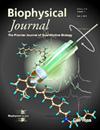Active and inactive pathways in the kinetic mechanism of the G51V retinitis pigmentosa mutant photoreaction.
IF 3.2
3区 生物学
Q2 BIOPHYSICS
引用次数: 0
Abstract
Autosomal dominant retinitis pigmentosa (ADRP) is a visual disorder which can result from many different mutations of the rhodopsin gene. In most cases the mutation results in a misfolded rhodopsin protein or a protein that does not bind with the retinal chromophore. Some mutations, however, yield rhodopsins which fold properly and bind the retinal chromophore, yet still result in ADRP. Here we investigate the activation mechanism of one such mutation which produces the G51V rhodopsin variant. Human WT and G51V were recombinantly produced and embedded in identical nanodiscs. Time-resolved spectra were then measured from the nanosecond to second time scales across the near UV through the visible spectral ranges. From these measurements the activation mechanisms of the two proteins were compared. While studies of the WT protein yielded a mechanism consistent with previous determinations of human rhodopsin (15), the G51V mechanism involved multiple pathways. These results suggest multiple ways for the protein to fold, some of which are photoactivated while the majority do not activate normally.G51V色素性视网膜炎突变体光反应动力学机制的活性和非活性途径。
常染色体显性视网膜色素变性(ADRP)是一种视紫红质基因突变引起的视觉疾病。在大多数情况下,突变导致错误折叠的视紫红质蛋白或不与视网膜发色团结合的蛋白质。然而,一些突变产生的视紫红质可以正确折叠并结合视网膜发色团,但仍然导致ADRP。在这里,我们研究了一种产生G51V视紫红质变异的突变的激活机制。重组制备了人WT和G51V,并将其嵌入到相同的纳米片中。然后测量了从纳秒到秒的时间尺度在近紫外到可见光谱范围内的时间分辨光谱。通过这些测量比较了两种蛋白的激活机制。虽然对WT蛋白的研究得出的机制与先前对人类视紫红质的测定一致(15),但G51V的机制涉及多种途径。这些结果表明蛋白质折叠有多种方式,其中一些是光激活的,而大多数是不正常激活的。
本文章由计算机程序翻译,如有差异,请以英文原文为准。
求助全文
约1分钟内获得全文
求助全文
来源期刊

Biophysical journal
生物-生物物理
CiteScore
6.10
自引率
5.90%
发文量
3090
审稿时长
2 months
期刊介绍:
BJ publishes original articles, letters, and perspectives on important problems in modern biophysics. The papers should be written so as to be of interest to a broad community of biophysicists. BJ welcomes experimental studies that employ quantitative physical approaches for the study of biological systems, including or spanning scales from molecule to whole organism. Experimental studies of a purely descriptive or phenomenological nature, with no theoretical or mechanistic underpinning, are not appropriate for publication in BJ. Theoretical studies should offer new insights into the understanding ofexperimental results or suggest new experimentally testable hypotheses. Articles reporting significant methodological or technological advances, which have potential to open new areas of biophysical investigation, are also suitable for publication in BJ. Papers describing improvements in accuracy or speed of existing methods or extra detail within methods described previously are not suitable for BJ.
 求助内容:
求助内容: 应助结果提醒方式:
应助结果提醒方式:


